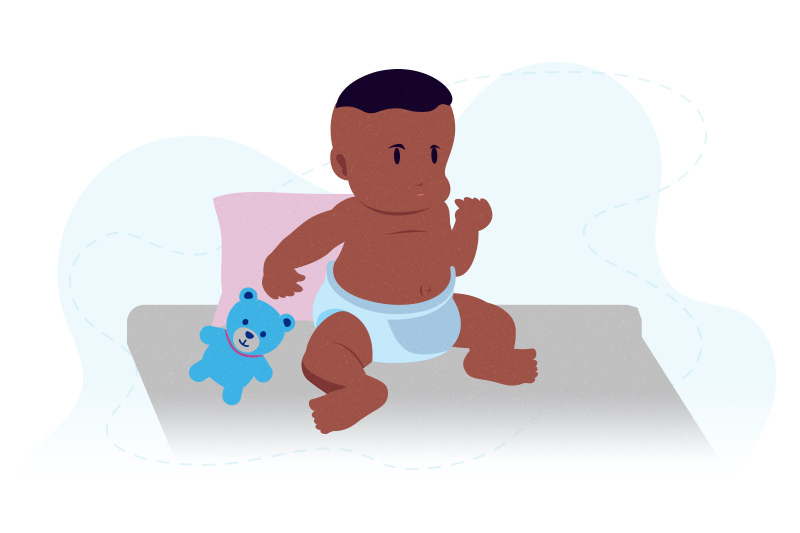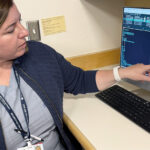Answers for parents whose baby is born with brachial plexus injury

Between one and three of every 1,000 babies is born with brachial plexus birth injury. The injury, which may be minor or severe, can impair movement and sensation in a baby’s arm. Because brachial plexus injuries take place during birth, usually without warning, the news leaves many new parents at a loss for what to do next.
Below, Dr. Andrea Bauer, an orthopedic surgeon with the Brachial Plexus Program at Boston Children’s Hospital, answers questions about brachial plexus birth injuries, treatment options, and the best time to seek treatment from a specialist.
What is brachial plexus birth injury?
We all have a network of nerves called the brachial plexus that runs from the spinal cord down the shoulders, arms, and hands. Various nerves within the brachial plexus send signals to and from the brain that control movement and sensation in each part of the arm.
Sometimes during a difficult birth, particularly if the baby is large or born breech (feet first), the brachial plexus can be stretched or torn. Damage to these nerves can cause weakness, numbness, or full or partial paralysis in the affected arm. Most brachial plexus birth injuries are not serious and heal on their own, but many serious injuries require surgery.
When should parents bring their baby with a brachial plexus injury to a specialist?
Possible brachial plexus birth injuries are almost always diagnosed at birth, but as parents, you don’t need to bring your child to a specialist right away. You can spend the first several weeks getting to know your baby and watching their arm for signs of recovery. Ideally, we like to see babies for the first time when they are 1 month old. After that, we’ll want to examine your baby once a month for the next three to six months.
Why do you need to see babies with brachial plexus birth injury so often?
Most of our information about the severity of an injury comes from repeated exams. This helps us look for signs that the nerves are healing on their own over time. If your child’s injury hasn’t shown signs of healing after several months, we may explore surgical treatments.
And parents have a lot of information to digest. We think it’s easier on you when you can meet our team and learn about your baby’s condition and treatment options over several visits. This can give you time to process the information and come back to us with questions. If your child does need surgery, you will already know us, and hopefully feel comfortable with us, by the time we’re scheduling the operation.
What is the treatment plan for babies with serious brachial plexus injuries?
Nearly all babies with brachial plexus birth injury will benefit from physical therapy, occupational therapy, or both. This helps strengthen the muscles in the arm and prevent contractures (tightening of the muscles and tendons around a joint). Therapy usually starts when a baby is 3 to 4 weeks old.
It’s possible your child will only need therapy. If your child has a more severe injury, there are two common types of surgeries.
The first surgery, on the nerves themselves, needs to take place within your baby’s first year, because the nerves actually supply nutrition to growing muscles that they need to survive. During this surgery, we either directly repair the injured area, or we transfer healthy nerves to the affected part of the arm where they can take over for the damaged nerves. Parents will typically start to see more arm movement a few months after the surgery, when the nerves have had time to regenerate.
The second surgery typically takes place between ages 1 and 3. This operation is most commonly a tendon transfer, which involves moving a functioning tendon to a new location where it can help restore function to a weak or injured muscle. After this procedure, your child can start physical therapy as soon as their post-surgical cast comes off. You can expect to see improvements almost immediately.
How do you work with out-of-state patients?
Boston Children’s is one of a few centers in the country with expertise in brachial plexus nerve surgery. Because of that, many of our patients come from other parts of the country, or even the world. When a family lives far away, we work closely with their local pediatrician, therapist, and specialist who can do the initial exams and send us their results. If the injury is not healing, the family will travel to Boston Children’s for an in-person consultation and again when their child is ready for surgery.
After nerve surgery, we often encourage families who live far away to receive some of their child’s follow-up care from their local provider. We continue to see many out-of-state patients both in person and through virtual visits to track their progress. But it’s easier on both patients and families when they can receive some of their care closer to home.
How does your research affect the way you care for babies with brachial plexus birth injury?
Most of our research focuses on ways we can improve patient care.
In one of our current studies, we’re looking into whether we can use magnetic resonance imaging (MRI) to determine the severity of brachial plexus birth injury very early in life. This may enable us to identify which patients need surgery earlier. If so, it could mean patients who are going to get better on their own may not have to come in for as many visits. Their parents wouldn’t experience as much stress wondering if their child will need surgery. Understanding the severity earlier may also enable us to perform surgery sooner on patients who need it.
We are also conducting a study of quality of life in patients who were born with brachial plexus injury. I hope this will give us a better understanding of which social and emotional factors outside of a medical setting have the most positive impacts on patients. Knowing this might help us further improve the way we care for children with this type of injury.
Learn more about the Brachial Plexus Program.
Related Posts :
-

Brachial plexus birth injury: Harper’s right arm
When Harper Jane Stalker was born with a limp, unmoving right arm in 2016, her parents had never heard of brachial ...
-

Football and family: Overcoming brachial plexus birth palsy
Chase is only a few months away from fulfilling a lifelong dream; playing college football. It’s a dream thousands ...
-

Ask a sports medicine specialist: Why are ACL tears so common among female athletes?
When an athlete is sprinting after an opponent who suddenly stops or changes direction, their anterior cruciate ligaments (ACLs) make ...
-

Forging a path back to school after orthopedic trauma
Orthopedic trauma can force children to miss school, sometimes for an extended period. But even when patients have regained enough ...





